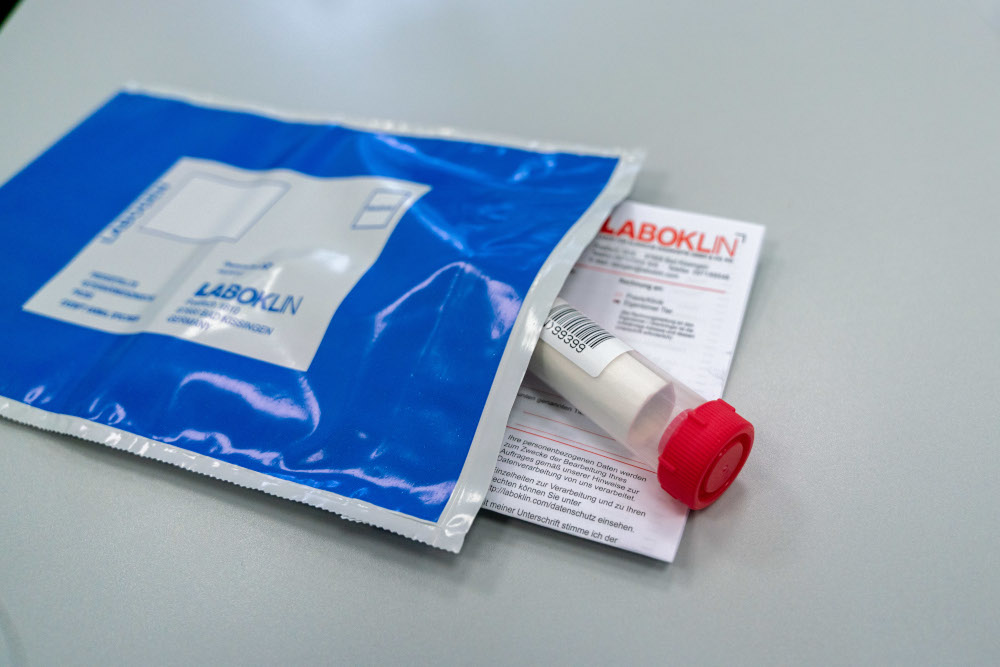Elementor #25
- Home
- Elementor #25
MDR1 Genvariante
Allgemeine Beschreibung
Ivermectin ist ein normalerweise sicher anzuwendendes Antiparasitikum, das bei einer intakten Blut-Hirn-Schranke nicht ins Gehirngewebe übergehen kann. Bei MDR1 betroffenen Tieren kommt es jedoch zu gravierenden neurotoxischen Effekten. Klinische Symptome betroffener Tiere können von Bewegungs- und Koordinationsstörungen, Desorientiertheit, Erbrechen und Zittern bis hin zu komatösen Zuständen reichen.
Rassen
Australian Shepherd, Bobtail, Border Collie, Collie (Kurzhaar/Langhaar), Deutscher Schäferhund, Elo, Langhaar-Whippet (Silken Windsprite), McNab , Miniature American Shepherd, Shetland Sheepdog (Sheltie), Silken Windhound, Weißer Schweizer Schäferhund, Wäller
Spezifikationen LABOGEN
Testnummer 8032
Trivialnamen MDR1-Defekt, Ivermectin
Unverträglichkeit, Medika-
mentenunverträglichkeit (MDR1)
Abkürzung MDR
Probenmaterial 0,5 ml EDTA Blut / (2x) Abstrich
Bearbeitungszeit 3-5 Werktage
Spezifikationen Variante
Symptomkomplex metabolisch
Erbgang autosomal-rezessiv; jedoch ist auch bei Trägern mit Überempfindlichkeit zu rechnen
Gen ABCB1
Mutation Deletion
Literatur OMIA:001402-9615
Detaillierte Beschreibung
Bei Rassen wie Australian Shepherd, Bobtail, Border Collie, Deutscher Schäferhund, Elo, Kurzhaar- und Langhaar-Collie, Langhaar Whippet, Mc Nab, Shetland Sheepdog, Silken Windhound, Wäller, Weißer Schweizer Schäferhund kann der sogenannte MDR1-Gendefekt zu einer Überempfindlichkeit auf Ivermectin, einem zur Parasitenbekämpfung verwendeten Wirkstoff, kommen. Dieser wird autosomal-rezessiv vererbt und lebensbedrohlich für die Tiere. Denn bereits eine geringe Dosierung führt zu schweren neurotoxischen Nebenwirkungen wie Bewegungs- und Koordinationsstörungen, Desorientiertheit, Erbrechen und Zittern bis hin zu komatösen Zuständen.
- Hund
- Katze
Wie gehe ich vor?
- We help ambitious businesses like
- yours generate more profits by building awareness, driving web
- traffic, connecting with customers, and growing overall sales. Give us a call.
What is included in the test kit?
How do I proceed?
Step 1: Preparation of the sample tubes

- 1 Label the sample tube:
- Stick one of the barcodes vertically onto the sample tube.
- Stick one of the barcodes vertically onto the sample tube.
- Use the same barcode number for the sample tube and the test request.
- Stick a barcode on the outer tube as well.
- Remaining barcodes can be discarded.
Step 2: Sampling

- 1. Preparation of the animal:
- The animal should not have eaten or suckled for approx. 1 - 2 hours before the sample is taken.
- Keep the animal separate from other animals during this period to avoid contamination of the swab with foreign DNA.

- 2. Carrying out the sample collection:
- Wash your hands thoroughly before taking the swab.

- Remove the swab from the packaging.
- Make sure that the padded part only comes into contact with the cheek mucosa of the animal to avoid contamination.

- Rub the padded side of the swab with light pressure along the inside of the cheek mucosa for approx. 10 seconds.

- Open the tube containing the liquid and insert the swab immediately.

- Bend the rod at the predetermined breaking point.

- Close the tube tightly and place it in the labelled outer tube.
Step 3: Shipping the sample material

- 1. Packing and shipping:
- Please put the tube together with the submission form in the enclosed return envelope.
- Put sufficient postage on the envelope and send it to the provided address.
- 2. Further notes:
- Use the barcode number for any queries (this is also stored online under "Your orders").
- You will be informed as soon as the first results are available.








